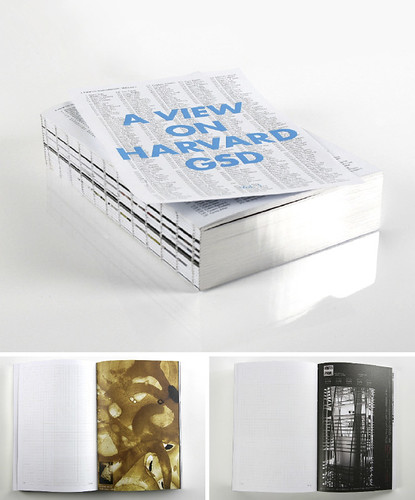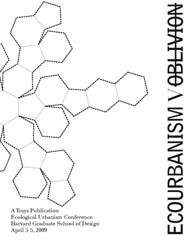Schmap used another one of my photos for their new Harlem guide (I've also contributed to thier Newport, Rhode Island guide). They are pretty neat looking free downloadable travel guides. Of course they don't have a Mac reader yet, so they aren't much use to me, but if you are a PC user or are travelling later then July of this year, you should check them out.
26.6.07
14.6.07
So, apparently a Boston Blog-News aggregator thingy called Universal Hub has been picking up my blog lately. Not as cool as my buddy's best Minneapolis blog of the year in 2005, but still enough to amuse me. I shall be adding a link.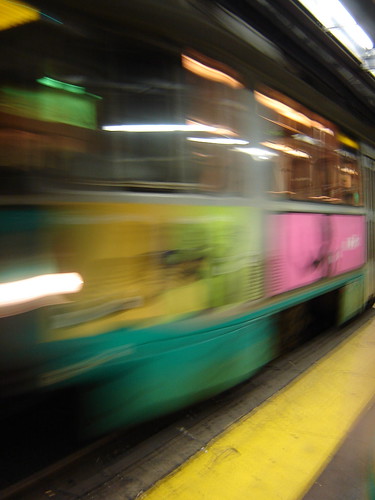
I've been taking a Transportation History class this semester (actually, it probably should be called Tangents Relating to Transportation History) and have come up with several amusing anecdotes for your enjoyment:
- You know how the Green Line takes a really tight turn between Boylston and Arlington? That's because there is a cemetery above the tunnel. They wanted to disturb as few bodies as possible when they were building it. Of course, this really freaked people out, so they used to have priest come down a bless the tunnel every now and then and they even used to whitewash the walls so that ghosts wouldn't have anywhere to hide.
- America didn't start having timezones until November 18, 1883. Before that, noon was whenever the sun was directly overhead (so Noon in Manhattan was 12:01 in Brooklyn and 11:59 in Jersey City). They railroads needed a way to regulate the train schedules so they pushed it through. Of course the Christian Fundamentalists of the time had a problem (surprise, surprise) with us not using "God's Time" so it wasn't made official until 1918 (way to go guys!)
- The first year that gas prices averaged around $1 per gallon was 1973. The last year that they did was in 1999. During the same time, the cost of a new car when from about $2000 to about $18,000 and the average cost of a house went from about $40,000 to about $250,000. So if anything, gas prices are way below inflation. Let's stop whining, huh?
- During the height of the construction of the Interstate, there was a plan in California to vaporise up a mountain with 22 atomic bombs so that they wouldn't have to tunnel through. The Kennedy Administration was on board because they wanted to demonstrate the peaceful uses of atomic weapons. Of course, they still didn't really understand radiation at the time, and if they had done it, Phoenix would probably still be uninhabitable.
12.6.07
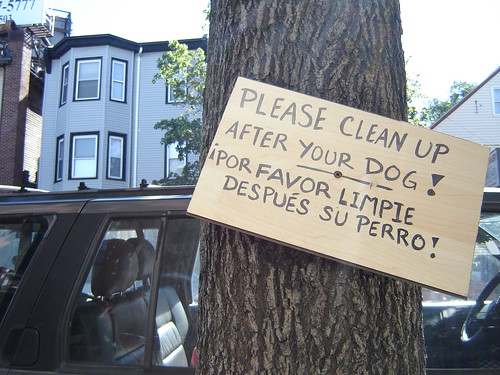
The summer is always a little bit of a weird time in Boston. Since there are so many students here, a lot of the leases for apartments turn over in the summer, so neighborhoods tend to have a big change over of residents all of the sudden instead of just a little bit at a time. Every year that we've lived in Eastie (we'll be starting our 4th in August) we've noticed a big change demographically about this time of year, and this year is no different. What is a bit strange is that it seems like the commercial scene of the neighborhood is catching up to the residential: that's right, Eastie now has it's first yuppie coffee shop.
Not that I'm complaining. Coming from a cold northern city, one of my biggest complaints about Boston is the complete lack of coffee shops that aren't Dunkin' Donuts. But is it kind of funny to have a place that is always full of hipster white kids in the middle of Eastie. Especially one that names their paninis after large condo complexes. I guess for me it's just a case of the first gentrifiers complaining about everybody who comes after them. It's like when you are a punk in high school and all of the little junior high punks kind of piss you off.
The other major change in the neighborhood is the two new parks (Memorial and Bremen St.) that just opened. From a planners perspective, it's amazing to see. The parks were created from unused industrial sites, one was a rail bed and the other a parking lot if I'm not mistaken. Both of the parks were pretty much completely full from the day they opened. It's one of those cases where you can really see that there was a need in the neighborhood that has now been filled. Plus it cuts a few minutes off of my walk to work, so that's a bonus as well.
Overall, it's been a pretty interesting process to watch in East Boston, but so far, I don't feel like the new people moving into the neighborhood have been displacing many old residents (at least not ones who didn't want to go). Rents have stayed pretty stable. But I kind of feel like this year we might be hitting a tipping point where the process is going to accelerate. It'll be interesting to see what happens next.
7.6.07
Inside/Outside
There is a pretty interesting article by architectural critic Philip Nobel in the newest Metropolis about the ICA in Boston (which I've also posted about before). 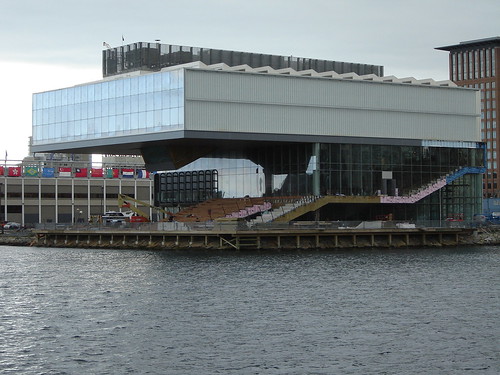
the ica when it was under construction
Now, obviously a critic is paid to be critical, so the article is a little down on the building. His biggest complaint seems to be about the way the building relates to its surroundings, which is a valid complaint considering the building is currently surrounding by nothing. It is a little silly though to complain about planning when there is already a plan in place and beginning construction.
Generally though, what I get from Nobel is that he's unhappy with the way the building is oriented. It turns it's back to the city, with it's harbor-side being the photogenic part and the interior most of its most interesting (architectural, philosophically) feature.
So here's my question: Is it important for every building to relate at street level to the city? Can some buildings work better (especially symbolically) relating at a skyline (or seashore) level? And, for a public building like a museum, is the interior (which, in the ICA, is an intense experience) perhaps the more important feature?
I'd love to hear ideas. For pictures of the museum check out my previous post on the subject or my flickr account.
**** I happened upon this quote today from the architect (Ricardo Scofidio) and thought it was pretty interesting:
"We began the project with the assumption that architecture would neither compete with the art nor be a neutral backdrop. It had to be a creative partner. The first step was to reconcile the paradox: the museum wanted to turn inward; the site wanted to turn the building outward. The building had to have double vision."


